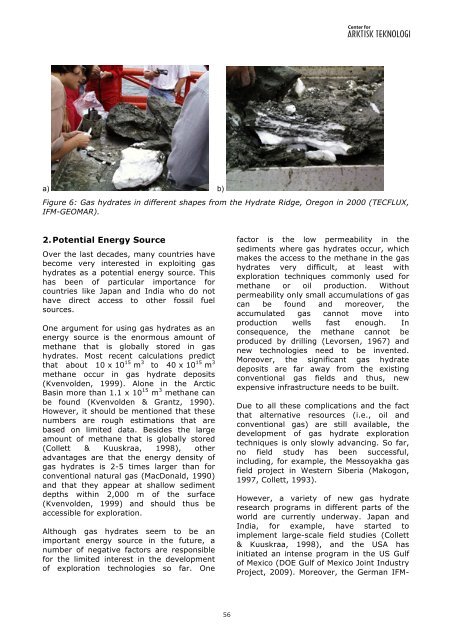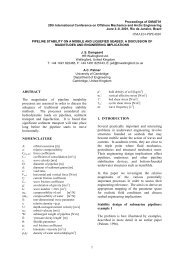Energiforsyning i Arktis – hvilken vej vælger Grønland? - Artek ...
Energiforsyning i Arktis – hvilken vej vælger Grønland? - Artek ...
Energiforsyning i Arktis – hvilken vej vælger Grønland? - Artek ...
You also want an ePaper? Increase the reach of your titles
YUMPU automatically turns print PDFs into web optimized ePapers that Google loves.
a) b)<br />
Figure 6: Gas hydrates in different shapes from the Hydrate Ridge, Oregon in 2000 (TECFLUX,<br />
IFM-GEOMAR).<br />
2. Potential Energy Source<br />
Over the last decades, many countries have<br />
become very interested in exploiting gas<br />
hydrates as a potential energy source. This<br />
has been of particular importance for<br />
countries like Japan and India who do not<br />
have direct access to other fossil fuel<br />
sources.<br />
One argument for using gas hydrates as an<br />
energy source is the enormous amount of<br />
methane that is globally stored in gas<br />
hydrates. Most recent calculations predict<br />
that about 10 x 10 15 m 3 to 40 x 10 15 m 3<br />
methane occur in gas hydrate deposits<br />
(Kvenvolden, 1999). Alone in the Arctic<br />
Basin more than 1.1 x 10 15 m 3 methane can<br />
be found (Kvenvolden & Grantz, 1990).<br />
However, it should be mentioned that these<br />
numbers are rough estimations that are<br />
based on limited data. Besides the large<br />
amount of methane that is globally stored<br />
(Collett & Kuuskraa, 1998), other<br />
advantages are that the energy density of<br />
gas hydrates is 2-5 times larger than for<br />
conventional natural gas (MacDonald, 1990)<br />
and that they appear at shallow sediment<br />
depths within 2,000 m of the surface<br />
(Kvenvolden, 1999) and should thus be<br />
accessible for exploration.<br />
Although gas hydrates seem to be an<br />
important energy source in the future, a<br />
number of negative factors are responsible<br />
for the limited interest in the development<br />
of exploration technologies so far. One<br />
56<br />
factor is the low permeability in the<br />
sediments where gas hydrates occur, which<br />
makes the access to the methane in the gas<br />
hydrates very difficult, at least with<br />
exploration techniques commonly used for<br />
methane or oil production. Without<br />
permeability only small accumulations of gas<br />
can be found and moreover, the<br />
accumulated gas cannot move into<br />
production wells fast enough. In<br />
consequence, the methane cannot be<br />
produced by drilling (Levorsen, 1967) and<br />
new technologies need to be invented.<br />
Moreover, the significant gas hydrate<br />
deposits are far away from the existing<br />
conventional gas fields and thus, new<br />
expensive infrastructure needs to be built.<br />
Due to all these complications and the fact<br />
that alternative resources (i.e., oil and<br />
conventional gas) are still available, the<br />
development of gas hydrate exploration<br />
techniques is only slowly advancing. So far,<br />
no field study has been successful,<br />
including, for example, the Messoyakha gas<br />
field project in Western Siberia (Makogon,<br />
1997, Collett, 1993).<br />
However, a variety of new gas hydrate<br />
research programs in different parts of the<br />
world are currently underway. Japan and<br />
India, for example, have started to<br />
implement large-scale field studies (Collett<br />
& Kuuskraa, 1998), and the USA has<br />
initiated an intense program in the US Gulf<br />
of Mexico (DOE Gulf of Mexico Joint Industry<br />
Project, 2009). Moreover, the German IFM-





